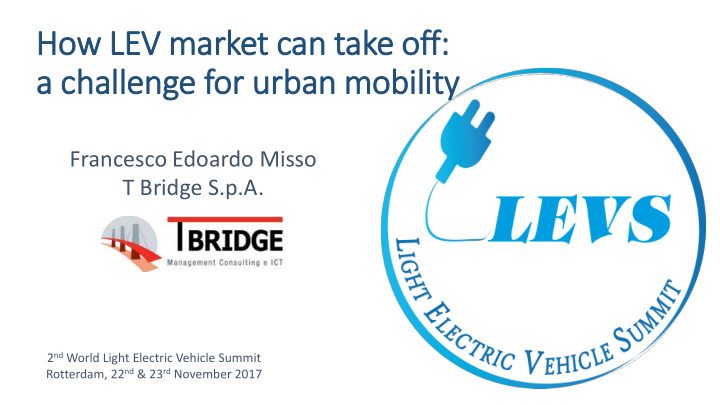



How LEV market can take off: a challenge for urban mobility Francesco Edoardo Misso T Bridge S.p.A. 2 nd World Light Electric Vehicle Summit Rotterdam, 22 nd & 23 rd November 2017
T Bridge and EU projects Since 2009 T Bridge has been working on European projects , both as technical partner and subcontractor The developed expertise include the phases of planning and implementation , starting from traditional T Bridge skills in transport and logistics The main themes concern sustainable and electric mobility and innovative systems T Bridge has been partner of former European projects, such as Ele.C.Tra (e-mobility) e Weeenmodels (environment)
ELVITEN project at at a a glance LIGHT ELECTRIC VEHICLES INTEGRATED WITH ELECTRIC AND TRANSPORTATION NETWORK DURATION/LIFETIME: 36 months (01/11/2017 – 30/10/2020) TOTAL COST: € 9,544,750 LEADER: INSTITUTE OF COMMUNICATION AND COMPUTER SYSTEMS (Greece) PARTNERS INVOLVED: 21 (of which LEV producers, ICT developers, charging point and e- roaming managers, associations, public bodies and research centres) COUNTRIES INVOLVED: 8 (7 in EU + CH) WEBSITE OF PROJECT: www.elviten-project.eu
Challenges to be tackled Limited direct experience with these vehicles Consumers’ worries about relatively high costs of Reasons which hamper these vehicles and perceived uncertainty about the wide spreading of LEVs need to recharge during a journey (range anxiety) Insufficient planning for LEV mobility OBJECTIVE Supply adequate use schemes, support services and ICT tools designed and offered to private users to spread awareness of the performance of these vehicles
How to face the obstacles OBSTACLES STATE-OF-THE-ART ELVITEN SOLUTIONS Lack of parking places Few car parks in cities means time Possibility of advanced booking of parking (free loss looking for parking in city centres) Poor security in e-bike parks Normal bike parks are not suitable for Dedicated, secure and sheltered parking e-bikes; high levels of theft and spaces vandalism Limited possibilities for charging Many Southern European cities do not E-roaming platform will connect existing have charging networks charging points. Guidelines will be drawn up for new charging points and removable batteries Low awareness and lack of Vehicle sharing is rare or poor Project data and results will allow integration of experience of LEVs among public LEVs in traffic and electric grid Low perception of safety, comfort LEVs are not being bought and Data collected will help producers to improve and reliability there are few dealers vehicles and meet customer expectations Performance anxiety Limited use due to poor battery life Charging points, ICT tools and the e- and lack of charging points Roaming platform will aid charging and reduce anxiety
ELVITEN actions Network of e-charging stations for LEVs integrated into charging circuit Installation of 'charging hubs' for all e-vehicles SERVICES Free use of e-vehicles provided by partners and encouraged by policies and incentives Brokering service to keep the status of vehicle readiness to use and their charge level . Users can return vehicles to a parking point (not necessarily the same one). More details on payment will be defined in the Business Models Access control system for charging areas ICT TOOLS Monitoring the fleet size of electric vehicles Serious Game application SmartCard / App for management of incentives Free parking spaces with reservation possibility POLICIES «Bonus» for virtuous behaviours Permanent exhibition and free test drive of electric vehicles Activities to raise awareness for different categories of potential users (commuters, COMMUNICATION tourists, couriers and companies)
Different approaches for user categories Systematic Occasional Companies with urban urban fast goods TARGET passengers passengers delivery V I S Replacement of Implementation of Replacement of CHANGES traditional vehicles sharing or rental services traditional vehicles with I with levs of levs levs O N TARGET Owners of electric Users of Delivery companies with GOAL vehicles LEV sharing service electric vehicles
Expected benefits encouraging the use of electric vehicles for citizens and local companies increasing the use of light electric vehicles instead of internal combustion vehicles raising awareness of e-mobility benefits promotion of virtuous behaviours concerning sustainable mobility reduction of pollution and traffic congestion creation of business models for light electric vehicle services
Project phases PREPARATION DEMOSTRATIONS ANALYSIS analysis service functionality analysis of the recorded of mobility demand travel data and users ’ opinions identification incentives for lev usage in of usage business plans to spread patterns, potentialities and the 6 pilot cities target users LEV 2017 2018 2019 2020
Demonstration activities The trials consider diversified activities in 6 European cities: charging, sharing, e-roaming, ICT tools and use of light electric vehicles e-bicycles e-quads e-scooters e-tricycles Private LEVs and 10 e-tricycles provided for sharing GENOA (Italy) 75 e-bicycles provided for sharing BARI (Italy) 78 e-bicycles provided for sharing ROME-IX MUNICIPALITY EUR (Italy) Private LEVs of different types BERLIN (Germany) 5 e-tricycles and 5 e-quads provided for sharing TRIKALA (Greece) 40 e-bicycles provided for sharing and private LEVs MALAGA (Spain)
11 This project has received funding from the European Union’s Horizon 2020 research and innovation programme under grant agreem ent No. 769926
Recommend
More recommend